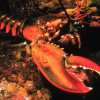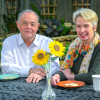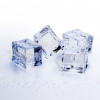Analysing the oven
Interview with
You know you’re in smart company when the oven that’s cooking your lunch has its own PhD student! Chris Smith spoke to Jamie Davidson from the University of Cambridge, and expert Yorkshire pudding maker, who comes from a department with a track record in food-related research forays...
Jamie - My group actually had a PhD in chocolate a few years ago so yeah, I’m not completely breaking the mould.
Chris - So you are really doing active laboratory research on this?
Jamie - Yeah, exactly. I’m actually looking at optimizing some parts of the design. Little things like how big the nozzles are, how many we need for the air jets, how big a fan we need, the position of the infrared lamps, that kind of thing, so that we really get the maximum possible performance out of the general design.
Chris - How do you actually understand what’s going on in there though? Have you got some kind of computer program that’s making measurements and then you can test different things?
Jamie - Yeah, exactly. I build a big model of the oven using a system called computational fluid dynamics. Basically you split the thing you’re trying to model into tiny little volumes, then you can solve all of your equations numerically over those tiny little volumes. And the model I’m using has 10 million little cubes and prisms making up the oven.
Chris - Essentially you’re dividing the interior of the oven up into lots of little spaces and considering each of them, solving the problems for what’s going on in each one, and then you add them all together to what the whole thing would do or is doing?
Jamie - Exactly.
Chris - How do you know what’s going on in each of the volumes though?
Jamie - we can make sure that the model is accurately capturing reality by devising a bunch of what you call validation experiments. Basically you have to come up with an experiment where you can directly compare results from the model to results from an experiment and minimise the errors of that, and then you can make a decision whether your model is accurate enough or whether you have to make changes.
Chris - Do you cook things with loads and loads of sensors in each of the bits of thing you’re cooking then, so you can work out what’s actually going on and then use that to inform how the model works?
Jamie - Partly. We are doing food trials but food is really complicated. So there will be a lot of different things going on there, you’d have mass transfer from the air in the oven to the food, and from the food into the air. You’d have a coupled heat transfer problem where you’d have to be solving equations for a solid and a fluid. That’s something that we are interested in but not something that really makes a good validation experiment. For validation you really want to be looking at a single piece of physics and whether the model is actually capturing that single piece of physics.
Chris - I suppose one bonus of your research is you actually get to eat it.
Jamie - Yeah well, thankfully now we’re in the restaurant I can eat it but, unfortunately, back in the lab it was very depressing because it’s not a food safe lab so I just had to throw it all away, which was devastating frankly.
Chris - And not very sustainable given this is all about eating and cooking with a conscience.
Jamie - Exactly, exactly. But thankfully now we’re here in Alex’s kitchen we can finally enjoy the fruits of our labour.










Comments
Add a comment